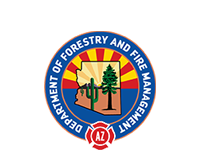***NEW*** Potential for Above Average Fire Activity in 2024 for Certain Areas of State Due to Increased Fuel Loading
Phoenix, AZ (3/18/2024) – The Arizona Department of Forestry and Fire Management (DFFM) along with the Bureau of Land Management, the US Forest Service, and local cooperating fire agencies brief with Governor Katie Hobbs about the upcoming wildland fire season and outlook for the summer months.
DFFM Fire Management Officer John Truett presented the outlook to the Governor and her staff followed by a presentation to the media during a press conference on Monday. This year, and due to heavy fuel loading, fire behavior analysts report the potential for higher-than-normal activity in particular parts of Arizona. Areas south of the Mogollon Rim, within the Tonto National Forest and across the Sonoran Desert landscapes, down into the Catalinas, and into Cochise County may see increased fire activity due to the amount of grass and brush in those areas. The potential exists for quick ignitions and rapid moving wildfire within the areas of heavy fine fuel where winds and terrain can influence fire behavior making it challenging for firefighters to contain. “Those parts of the state have more than double the amount of fuel loading as in years past due to winter rains over the last few years. As we move into spring, and as drier and warmer conditions follow, that fuel dries out very quickly. Areas within the Sonoran Desert and into southern Arizona could see an uptick in fire activity with fires spreading very rapidly,” said DFFM Fire Management Officer John Truett.
As for the high country, fire behavior analysts report a delayed start to fire season due to the existing snowpack. However, unlike last year, that snowpack may melt sooner as warm temperatures enter the state. Forecasters say by May Arizona could see the start of our typical summer pattern of hot and dry conditions. Those conditions can signal the start of Arizona’s fire season.
In 2023, firefighters responded to 1,837 fires on State, Federal, and Tribal lands. Those fires burned approximately 188,000 acres with 71% reported as human-caused. Last year, Arizona’s largest fire, the Pilot Fire started on July 1, east of Wikieup, within the Mohon Mountains. It reached 34,810 acres before firefighters could call it 100% contained on August 12, more than one month after it started.
Next Monday, March 25, Southwest Wildfire Awareness Week kicks off in Arizona and New Mexico with this year’s theme: A Time for Action. The week helps amplify wildfire prevention and outreach messaging prior to the states’ critical fire timeframes. To promote the week, DFFM and partners will focus on increased social media messaging, public service announcements, and public outreach events. “A Time for Action” signifies getting homeowners to start creating defensible space around homes and around properties. DFFM and its federal and tribal partners work annually conducing fuels reduction and prescribed burn projects to reduce the wildfire risk around communities. Home repair, seasonal cleanup, taking care of plants, and removing trash and debris from around the home are just a few ways to prepare your home for wildfire. This year, DFFM also unveils a new marketing campaign at gas stations aimed at reducing roadside fires and other prevention information.
For additional fire prevention or community protection tips, visit wildlandfire.az.gov or Firewise USA. Download DFFM’s free mobile phone application from the iTunes or Google Play stores for important resources, such as wildfire smoke forecasts, wildfire and fire prevention information, forestry content and much more.
###


